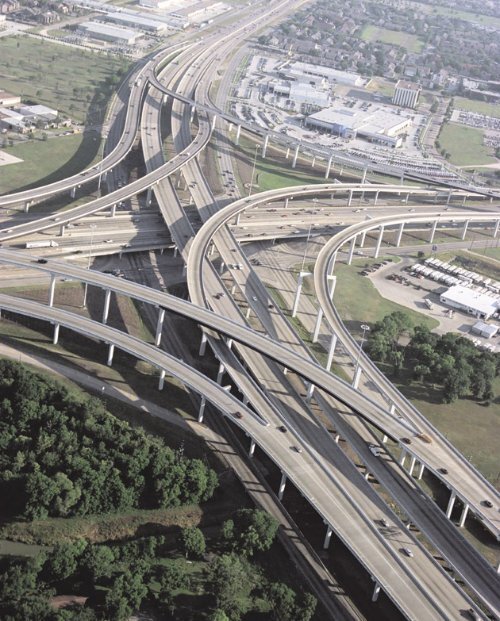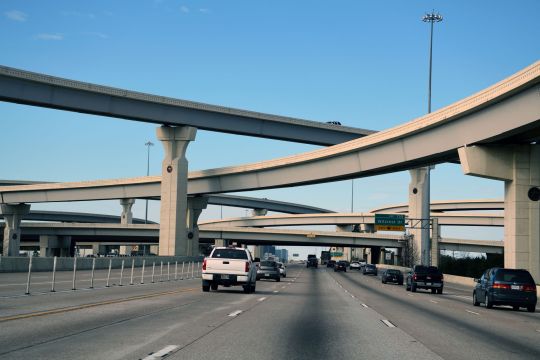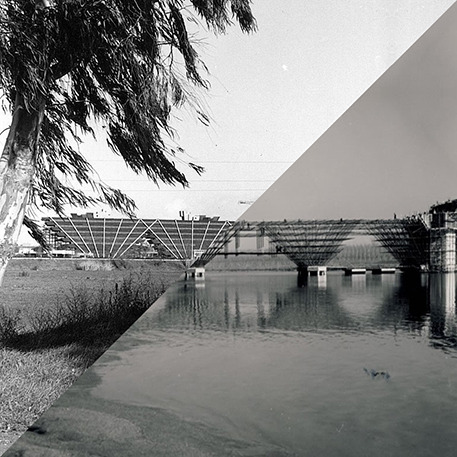#highway construction
Explore tagged Tumblr posts
Photo

Road construction on interstate 35W in South Minneapolis with the city skyline in the background.
#35W#Construction#Highway Construction#Minneapolis#Minneapolis Skyline#Snow#South Minneapolis#Winter
11 notes
·
View notes
Text
Excerpt from this New York Times story:
When Interstate 25 was constructed through Denver, highway engineers moved a river.
It was the 1950s, and nothing was going to get in the way of building a national highway system. Colorado’s governor and other dignitaries, including the chief engineer of the state highway department, acknowledged the moment by posing for a photo standing on bulldozer tracks, next to the trench that would become Interstate 25.
Today, state highway departments have rebranded as transportation agencies, but building, fixing and expanding highways is still mostly what they do.
So it was notable when, in 2022, the head of Colorado’s Department of Transportation called off a long planned widening of Interstate 25. The decision to do nothing was arguably more consequential than the alternative. By not expanding the highway, the agency offered a new vision for the future of transportation planning.
In Colorado, that new vision was catalyzed by climate change. In 2019, Gov. Jared Polis signed a law that required the state to reduce greenhouse gas emissions by 90 percent within 30 years. As the state tried to figure out how it would get there, it zeroed in on drivers. Transportation is the largest single contributor to greenhouse gas emissions in the United States, accounting for about 30 percent of the total; 60 percent of that comes from cars and trucks. To reduce emissions, Coloradans would have to drive less.
An effective bit of bureaucracy drove that message home. After sustained lobbying from climate and environmental justice activists, the Transportation Commission of Colorado adopted a formal rule that makes the state transportation agency, along with Colorado’s five metropolitan planning organizations, demonstrate how new projects, including highways, reduce greenhouse gas emissions. If they don’t, they could lose funding.
Within a year of the rule’s adoption in 2021, Colorado’s Department of Transportation, or CDOT, had canceled two major highway expansions, including Interstate 25, and shifted $100 million to transit projects. In 2022, a regional planning body in Denver reallocated $900 million from highway expansions to so-called multimodal projects, including faster buses and better bike lanes.
Now, other states are following Colorado’s lead. Last year, Minnesota passed a $7.8 billion transportation spending package with provisions modeled on Colorado’s greenhouse gas rule. Any project that added road capacity would have to demonstrate how it contributed to statewide greenhouse gas reduction targets. Maryland is considering similar legislation, as is New York.
15 notes
·
View notes
Note
???? This is not a purely American thing. Welcome to spaghetti junction, Birmingham, England.

ive never liked the phrase "manmade horrors beyond your comprehension" but i cant think of a better way to describe texas roads


biblically accurate highway
40K notes
·
View notes
Text

"TRANS-CANADA HIGHWAY NEARING COMPLETION," Toronto Star. March 27, 1934. Page 2. ---- East and west sections of the Trans-Canada highway will be completed this year. The western section here shown runs from Schreiber to Nipigon, Oskondigo, English River, Dyment, Vermillion, Kenora and the Manitoba boundary. Between the east and west sections a compromise route is to be taken, according to announcement by Hon. William Finlayson. This will run from Cochrane to Hearst and southwest to White River, joining at that point with a section to be built northwest from the Soo. The Trans-Canada is 1,300 miles long in Ontario and to date the road has cost $12,000,000.
#trans-canada highway#northwestern ontario#kenora#thunder bay#road building#road work#highway construction#great depression in canada#nipigon#schreiber
0 notes
Text
youtube
#malir expressway#road construction#road carpeting#highway construction#karachi malir expressway construction#Youtube
0 notes
Text
Highway crew goes over the line
As a general rule I am not inclined to gripe about the Texas highway department’s construction crews. I am making an exception based on an experience I had today. I was returning home from a quick trip to Beaumont, where I paid my respects at the funeral of a dear friend. I was driving north along U.S. Highway 69 through the Piney Woods; I veered onto a toll road and got back onto U.S. 69 south…
View On WordPress
0 notes
Text
VRC Construction: Setting New Standards in Highway Construction in India

With its extraordinary skills and dedication to perfection, VRC Construction, a well-known Civil contractor in India, is creating waves in the construction sector. They have distinguished themselves as a top highway construction company in India, thanks to a track record of success and a committed team of experts.
VRC Construction has established itself as a trustworthy partner for infrastructure development projects in India as a top civil contractor in India. The company has built a solid reputation as the Best construction company in Delhi and the go-to option for road construction projects in India because of its strong focus on providing top-notch construction services. VRC Construction’s portfolio of accomplished roadway construction projects demonstrates its dedication to quality. Due to this, they swiftly became the Best road construction company in India.
The business has continually produced outstanding outcomes by utilizing its technological know-how, cutting-edge machinery, and creative construction methods. They make sure that every phase of a highway construction project is handle with the utmost expertise and accuracy, from planning and design to execution and project management.
Why Hire VRC Construction As A Civil Contractor in India?
The dedicated team of highly qualified specialists at VRC Construction is one of the main factors in the success of the company as a civil contractor in India. The business is proud of its skilled personnel, which consists of knowledgeable construction experts, project managers, and engineers with extensive experience in the nuances of highway construction. With this knowledge, VRC Construction is able to handle challenging projects with ease and produce excellent outcomes that go above and beyond customer expectations. This is the prime reason for this company to be chosen over others and remain the Best road construction company in India.
The VRC Construction’s devotion to global standards and best practices in the construction business further demonstrates its dedication to excellence. For its projects to be both structurally and environmentally sound, this Best construction company in Delhi places a high priority on safety, environmental sustainability, and the use of cutting-edge building technologies.
VRC Construction has been named the Top highway construction company in India, a testament to its competence. Clients from the public and commercial sectors have come to trust and rely on the company because of its ability to regularly deliver high-quality projects on schedule. VRC Construction places a high priority on customer satisfaction and works to forge lasting relationships with each of its clients by offering customized building solutions.
What Makes Them Different From Others?
One company distinguishes out from the others in the dynamic field of building, where projects are as varied as the structures they produce. Their team of seasoned experts, state-of-the-art technology, and customer-centric attitude have earned them a reputation for excellence in terms of both output and client satisfaction.
Because of their expertise, creativity, and unwavering commitment to meeting the demands of its customers, this organisation is the first choice of those searching for high-quality building in any field. Listed below are just a handful of the ways in which VRC Construction stands apart from the competition.
Project Management
When hiring a civil contractor in India, you need them to manage your project efficiently and VRC Construction is the right choice. Project management is a strength of prosperous construction firms. They have established procedures for efficiently organizing, planning and carrying out tasks. Timelines are fulfill, resources are used wisely, and potential problems are head-on handle with effective project management.
Wide-ranging Services
A construction company that distinguishes out from the competition is one that provides a wide range of services. preparing, design, engineering, procurement, construction management, and support after a project is built are all examples of services that might be provided. By providing a wide range of services under one roof, VRC Construction streamlines the building process for its customers and eliminates the need for several experts.
Safety precautions
One essential characteristic that distinguishes this Civil contractor in India
is its commitment to safety. A company’s dedication to safeguarding its staff and completing projects without incidents or accidents is demonstrated by its priority of employee well-being, adherence to stringent safety regulations, and upkeep of a safe working environment. A solid safety record enhances the business’s reputation and inspires client confidence.
Monetary stability
A financially sound construction company is frequently regarded as a trustworthy and trusted partner. Having the required financial resources enables the business to make investments in tools, supplies, and qualified staff without jeopardizing project quality or timetables. Clients’ faith in the company’s capacity to finish projects despite difficult economic situations is bolstered by its financial stability.
Reputation
Strong differentiators for a construction company include its standing in the field and its clients’ glowing testimonials. An organization can draw in new customers and distinguish itself from rivals by establishing a strong reputation based on a track record of completed projects, happy clients, and ethical business practices. Positive comments and endorsements show the business’s advantages and give potential customers faith in it.
Conclusion
VRC Construction, a renowned Civil contractor in India, has achieved a distinguished reputation in the construction industry for its expertise, commitment to quality, and skilled team. Their track record of successful projects and adherence to global standards sets them apart from other construction companies.
By consistently delivering exceptional outcomes and exceeding client expectations, VRC Construction continues to raise the bar in the field of construction, solidifying its position as the best road construction company in India.
Source Link: — https://www.dailybusinesstime.com/vrc-construction-setting-new-standards-in-highway-construction-in-india/
0 notes
Text
aftg miraculous au where kevneil are the main pair miraculous holders, wymack is the guardian. kevin keeps trying to get andrew to use his miraculous but andrew is like 'yah.... i aint doing all that.' (but he accepts it so he can protect aaron and nicky and eventually kevin, even tho he wouldn't know kevin is kevin bc of the whole secret identities thing) neil would be the fox one and kev would be ladybug and honestly would andrew be chat noir? he is very cat. stubborn. wears all black. etc. riko would be chloe (but actually a threat lol) and tetsuji is hawkmoth omg... him TRYING TO REVIVE KAYLEIGH .!!!.??? is this anything
#category 3 neurodivergebt moment happening here guys id apologize but the brainworms have wormed into my brain ad u can see.#this is all just for silly fun#kev would pester andrew to accept his miraculous#and andrew would say yes and keep throwing it off the highway <3#luniaisun#WOULD ANDREW BE A SPEAR AND THEN DISCOVER AARON AFTER AND DECIDE TO TAKE THE MIRACULOUS#i fear im constructing a plot
28 notes
·
View notes
Text
✨A💕O🔥3…P🥳O⚡️S💞T‼️‼️‼️
TA-DAAAAAAAA 🕺🏾🕺🏾🕺🏾🕺🏾🕺🏾🕺🏾
So…yeah guys! As promised (and most DEF not a couple days late…): here is the poll determining which should be my first fic I post of Ao3 😌💞!!!
If you need a reading refresher to decide which fic to pick, I linked my TMNT masterpost down below ☺️💕:
REBLOGS ARE APPRECIATED‼️‼️‼️ LETS GET AS MANY PEOPLE TO VOTE AS WE CAN‼️‼️‼️
#Emery’s rambles#Polls#Tumblr polls#Writer’s on Tumblr#Not gonna be too long until I call myself a writer on aO3 AHHHHHHFHHDHDHAJAJAAK#S P I N N I N G AND S W I M M I N G RIGHT NOW AHHHHH#Gonna rewrite the one you guys pick tho ofc#Can’t let the ao3 homies know I fw tickling 🙃#MNVBFHJE#Giggling at the link..#Poor Casey getting cropped out H A H#Also don’t mind the link looking like it went straight through a bust highway..#It’s under construction :3#Tmnt tickle#Rottmnt tickle#Tmnt 2012 tickle#Tmnt 2003 tickle#Mutant Mayhem tickle
37 notes
·
View notes
Text

New Houses along the Old Highway
Staring at the Sun series
Hasselblad 500c/m
Kodak Tmax 400iso
#New Houses#Staring at the Sun#photography#photo#construction#lincoln highway#film#film photography#summer#illinois#photographers on tumblr#original photographers#photographerslife#hasselblad#film is not dead#kodak#travel#road trip#architecture#sun#old highway#midwest
40 notes
·
View notes
Text

#road sign#road safety#road construction#highway#road trip#driving#trashcore#trashy aesthetic#trash#trashy#rain#rainy day#rural#ruralcore#rural america#rural aesthetic#rural gothic#low brow art#meme humor#funny humor#memes#lol#childish behavior#puerile#potty humor
16 notes
·
View notes
Text

Construction of the Greater New Orleans (GNO) Bridge over the Mississippi River in New Orleans, Louisiana - 1954 to 1958.
#new orleans#old new orleans#bridges#cantilever bridges#bridge building#steel working#construction#civil engineering#construction projects#infrastructure#roads & bridges#bridges & highways#engineering#steel workers#public works#bridge design#gno bridge
7 notes
·
View notes
Text
It’s crazy to think after all the dangerous shit my brother did and all the close calls, in the end he died in his sleep painlessly. I do feel really lucky for that
#when we were teenagers he jumped off the roof of the house. he used to just wander around highways high as fuck#tried to hang himself one time. he recently had a major seizure on his construction job site and nearly fell into a massive ditch.#just to die curled up in bed in his sleep
7 notes
·
View notes
Text

"Roadbuilders Forge On to Alaska," Ottawa Citizen. October 8, 1942. Page 3. --- Workers on the new "Alcan" military road across Canada to connect the U.S. with Alaska are making rapid progress as they equalize topography by cutting through hilltops such as that shown above.
#alaska highway#highway construction#road construction#alcan highway#pacific war#world war ii#canada during world war 2#military road
0 notes
Text

Julio Lafuente, Gaetano Rebecchini and Calogero Benedetti, Edificio Esso, Rome, Italy, 1977-1980 VS Silvano Zorzi and Giorgio Macchi, bridge over the Po River, Autostrada del Sole (A1 Motorway), Mortizza | Piacenza, Italy, 1957-1958 (construction site photo)
#julio lafuente#Gaetano Rebecchini#Calogero Benedetti#esso#roma#rome#magliana#italy#italia#silvano zorzi#bridge#motorway#highway#a1#autostrada#autostrada del sole#mortizza#piacenza#po#fiume po#river#po river#Engineering#building#architecture#collage#construction site
32 notes
·
View notes
Text

The East Side Express Highway (now the FDR Drive), here on the Lower East Side, under construction, June 25, 1937.
Photo: Associated Press via Gizmodo Australia
#vintage New York#1930s#East Side Highway#East Side Hwy#FDR Drive#vintage NYC#vintage Manhattan#highways#construction#June 25#25 June
60 notes
·
View notes